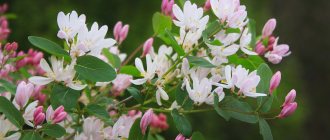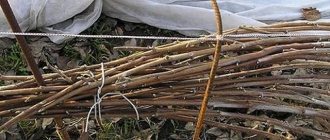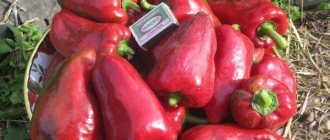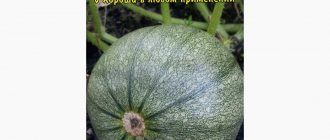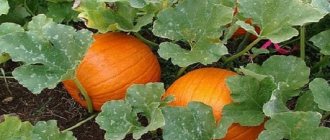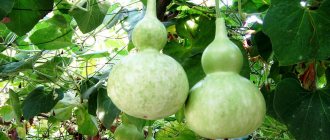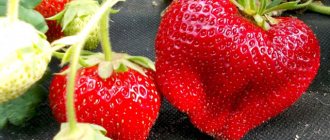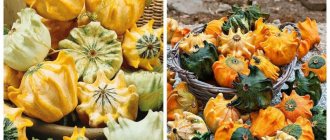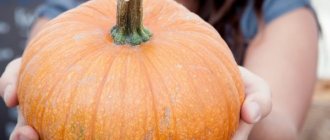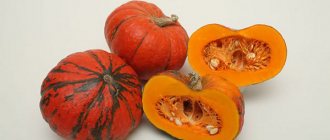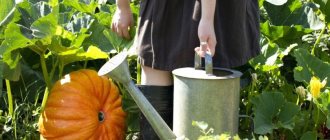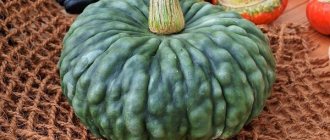Vegetable growing » Pumpkin
0
584
Article rating
Kira Stoletova
Atlant pumpkin is a mid-season variety that is distinguished by its large size and high taste. The vegetable has beneficial properties and contains many vitamins.
Growing pumpkin Atlant
Description of the pumpkin variety
Atlant is an amazing variety with the largest fruits in the world. In some cases, the weight of the pumpkin reaches 100-150 kg! The vegetable is excellent for processing; tasty and healthy dishes are prepared from it for the winter.
Distinctive features
Belongs to late-ripening varieties, ripens in 110-130 days from planting. The vegetable is grown in open ground.
The bushes are spreading and powerful. Thanks to its thick peel, the vegetable can be stored for a long time without losing its properties.
Fruit characteristics and yield
The fruits are oval-round, bright orange in color. The surface is slightly ribbed. The average pumpkin weight is from 10 to 30 kg. The pulp is juicy and sweet, yellow in appetizing color.
Pumpkin is used fried, boiled and steamed. The seeds of the variety are large and light beige in color. Productivity is stable, from 1 sq. m on average, 10-15 kg of fruits are collected.
Interesting ! 100 g of pumpkin contains only 25 kcal. The vegetable is often used as the main ingredient for preparing dietary dishes.
Characteristics of the variety
This variety of pumpkin differs from its analogues in its size. The fruit is bright orange, round in shape, which is divided into lobes by vertical lines. The bush is climbing, but due to the size of the fruits this does not interfere with harvesting.
The leaves are medium sized, round in shape, with pointed ends, dark green in color. The fruits are mid-ripening, full ripening occurs in 120-130 days. The peel is thick, dense, and the flesh is tender and juicy, has a sweet taste, and a pronounced fragrant pumpkin aroma. Its thickness ranges from 5 to 8 cm.
Pumpkin contains many B vitamins, as well as vitamins A, E, C. It contains various microelements: magnesium, potassium, phosphorus, zinc, iron.
The weight of one fruit can reach 60 kg, but more often pumpkins grow no more than 25 kg. The plant is frost-resistant, has immunity to various bacterial and viral diseases, especially powdery mildew and fruit rot.
Due to the thickness of the peel and resistance to various ailments, Atlant is perfectly transportable over long distances and can be stored for up to 1 year.
Pumpkins are used in different ways. They are a dietary product, therefore they are recommended for various diseases associated with the endocrine, cardiovascular systems and gastrointestinal tract.
Pumpkins can be baked, steamed, boiled or made into soups. These fruits make excellent purees and juices that can be given to young children. Pumpkin is used in medicine and cosmetology.
How to grow
In the north of the country, pumpkin is grown in seedlings so that the plants quickly adapt to difficult climatic conditions. In warm regions, the vegetable is planted with seeds in open ground. Let's take a closer look at each method and rules for caring for the Atlant variety.
Planting by seeds
Experienced summer residents purchase seeds from trusted manufacturers. When purchasing, pay attention to the integrity of the packaging and the expiration date of the material. At home, the seeds are inspected for external defects, and damaged specimens are thrown away.
It is advisable to check the seeds for germination. To do this, they are placed in a jar of water and stirred. Those seeds that sank to the bottom are used for sowing.
They are first disinfected using one of the proposed methods:
- soak for 20 minutes in a solution of potassium permanganate;
- leave for a day in aloe juice;
- treated with a solution of hydrogen peroxide;
- leave for 7 days on the veranda or loggia to warm up.
To plant pumpkins, choose the early morning of a windless day. The culture prefers sunny and spacious beds, away from underground groundwater. The soil is first cleared of debris and weeds and dug to a depth of 15-20 cm.
To make the soil more nutritious, the beds are sprinkled with a mixture of lime and wood ash. This procedure reduces the acidity level and saturates the earth with beneficial properties. Next, make grooves at a distance of at least 80-100 cm. Place 2 seeds in each hole, sprinkle with earth on top and water generously with warm water.
Planting seedlings
For seedlings, in addition to disinfected seeds, a suitable container is required. Summer residents advise planting pumpkins in large containers or cassettes to avoid diving in the future. The container is pre-washed and treated with a solution of potassium permanganate.
Many people prefer to use ready-made soil mixtures as seedling soil. Simply pour the soil into a container, make small holes and cover the seeds with soil. Grow seedlings on a sunny and bright windowsill. If there is a lack of sun, additional illumination is provided with phytolamps, which can be purchased at any gardening store.
Important ! Caring for seedlings involves regular watering and fertilizers. Moisten the seedlings as the soil dries out. It is important not to over-water the bushes, as excess moisture can lead to the development of diseases. Under no circumstances should you water the pumpkin with cold water - use clean water from a filter at room temperature. Feed the sprouts after the first leaves appear. Plants respond well to fertilizing with liquid bird droppings or infusion of burdock leaves.
Care
Rainwater is best suited for irrigation. It is softer than any other, all vegetables “love” it. To ensure that there is always a supply of rainwater at hand, gardeners connect a drainpipe to a tank or collection tank.
If this is not possible, the beds are moistened with tap water, after keeping it in the sun for at least two hours. About 2-3 liters are consumed per bush. The interval between watering is approximately 4-5 days. If the summer turns out to be rainy, the number of procedures is reduced.
Before watering, it is recommended to weed the beds and loosen the soil . These procedures improve the quality of the soil, making it lighter and airier. Removing weeds is necessary to maintain healthy microflora in the beds. If this is not done, the risk of diseases and insect pests increases significantly. Also, healthy care is impossible without regular feeding.
Gardeners use the following methods:
- During the flowering period, the bushes are watered with a solution of Bordeaux mixture or copper sulfate. The products protect plants from germs and bacteria.
- 2 weeks after the first feeding, wood ash or liquid manure is added. Fertilizing has a beneficial effect on the development of the root system.
- During the fruiting period, ammonium nitrate or superphosphate is added. The drugs improve the taste of vegetables.
Features of cultivation and possible difficulties
To speed up the ripening of the fruits of the Atlant variety, summer residents advise forming bushes and pinching their tops. To do this, a month after planting, remove excess ovaries, leaving 2-3 fruits on one bush. If this is not done, many small fruits will form that will not have time to gain weight and ripen. If the fruits are formed correctly, there will not be many fruits, but the pumpkins will grow large and sweet.
Important ! To prevent vegetables from lying on the ground, additional supports are built. For example, they place a wooden board under the fruit. Such a simple structure prevents damage and rotting of the pumpkin, which can occur from contact with wet soil.
Particular attention is paid to the lashes. In the Atlant variety they are long, so they are regularly untangled and neatly laid out on the garden bed, sprinkled with earth. Additional roots sometimes appear in places where the powder is applied. This allows you to increase productivity.
Growing tips from experienced gardeners
Let's study tips and recommendations from experienced gardeners, with the help of which even beginners will be able to grow a tasty and beautiful harvest:
- before planting in the garden, seedlings are hardened in the freezer for 3-4 days;
- the best predecessors for the crop are legumes, greens or potatoes;
- to obtain the highest yield, vegetables are planted according to a 2x2 pattern;
- before sowing, water and fertilizers are added to the holes;
- water the plants in the morning or evening to avoid sunburn;
- the water temperature for irrigation must be at least +20 °C;
- for convenience, when watering pumpkins, use a drip system or hose;
- The bushes are sprayed with manganese or whey 2-3 times per season, this protects against pests.
Diseases and pests
Bacteriosis occurs in pumpkin patches. The causes of the disease lie in improper care, waterlogging or contaminated soil. The infection can also be carried by insects, birds, and the remains of old plants. Bacteriosis manifests itself in the wilting of the bushes, the fruits become soft, the leaves become covered with small spots. For preventive purposes, sprays based on onion peels are used. For treatment, use 0.4% copper oxychloride or Bordeaux mixture.
Another disease is powdery mildew. It appears as a white coating on the leaves, which disrupts metabolism in the bushes. The leaves gradually dry out, the stems and petioles are affected. Powdery mildew progresses with an excess of nitrogen-containing fertilizers and poor watering. Affected specimens are sprayed with a solution based on colloidal sulfur. For prevention, treatment with soapy liquid is used.
Important ! Among the insect pests in the beds, mole crickets or wireworms are noticed. They destroy the root system, which is why the entire bush soon withers. To prevent their appearance, the beds are sprinkled with dry eggshells or the drugs “Prestige” or “Provotox” are added to the soil.
Features of cultivation
This variety can be grown in two ways:
- in open ground;
- using seedlings.
Seeds are planted in open ground. Before this, they can be treated with a concentrated solution of potassium permanganate or soaked in water for several hours until white spouts appear. Seeds should be planted in April, when the ground has already warmed up to at least 10 °C.
Special holes are made for the seeds; 2-3 pieces are placed in each hole with the spouts up, after thoroughly watering the soil and adding ash. After 3 months the first harvest will appear.
Plants need good care
The best way to grow crops is with seedlings, especially in the northern regions. This way the plant takes root faster and produces a good harvest. You need to prepare the seedlings yourself. First, buy the required number of seeds.
For them you need to take natural fabric or gauze folded in 2-4 layers. You need to wet the cloth, put the seeds inside and cover them. Leave the material for 3-4 days, during which the fabric must be wetted when it dries.
You can put these seeds in the refrigerator for a day directly in the fabric, this helps the plant become frost-resistant. Small containers are prepared for seedlings; ordinary plastic cups can be used, but peat pots are better suited.
Pre-prepare the soil; it should be with mineral fertilizers. Seeds are planted to a depth of 2-3 cm so that the seedlings germinate through the ground. Afterwards, the seedlings are watered abundantly and covered with film. Leave it like this for a month, watering 1-2 times every two weeks.
You need to choose a time for landing in advance. The description says that seedlings are prepared from the 20th of April to May 10, and planting in open ground - from May 10 to June 20. The ground temperature must be at least 10 °C. Because The bushes tend to weave, so it is optimal to plant sprouts in a pattern of 90 x 150 cm.
The plant requires proper care. Choose a warm and well-lit place. For the Atlant variety, soil with low acidity but with a large amount of organic fertilizers is more suitable. The plant tolerates drought well and is resistant to rot and powdery mildew.
To get a good harvest, you need to regularly water the pumpkin bush. Moisten it immediately after planting, and then every week so that one bush needs 1 bucket of water per week. Do not water the bush after the fruit has set. If the soil moisture is sufficient, the pumpkins will ripen well without watering.
Harvesting and application
Atlant pumpkin is harvested from the garden in early or mid-September . To keep the fruits as long as possible, they are cut off along with the stalk. Before storage, pumpkins are not washed with water, but wiped with a dry and clean cloth.
Store the fruits in a cellar or basement. The optimal humidity temperature for storage is no more than 80%. Summer residents put vegetables in wooden boxes and cover them with newspapers or thin polyethylene.
Part of the harvest is processed immediately. The sweet and buttery pulp is great for making porridges and side dishes, salads and pureed soups. Pumpkin makes excellent sweet dishes: the product is added to pies, cakes and muffins are made from it.
Pumpkin gives the dish not only taste and benefits, but also an appetizing appearance. Due to the high content of beneficial microelements, the vegetable is suitable for a dietary and healthy diet. Pumpkin goes harmoniously with other vegetables and is used when making jam or jam.
Interesting ! In addition to the pulp, seeds and even flowers of the plant are used for cooking.
Advantages and disadvantages of the variety
The size of the Atlant pumpkin is both an advantage and a disadvantage. Some gardeners appreciate the large size of the fruit, while others, on the contrary, do not know what to do with such large vegetables.
The advantages of the variety include a sweet and juicy taste, a pleasant aroma. Pumpkin does not require special growing rules for care, but difficulties may arise with the formation of bushes. Otherwise, Atlant pumpkin is a high-yielding vegetable with excellent external and internal characteristics.
General characteristics of the variety
Atlant is considered a sweet variety, which contains 15% sugar, 20-22% starch, vitamins E, B2, B1, C. It is used for making desserts, cereals, casseroles, baby food, juices, and jam. If necessary, it is used as feed for farm animals.
The bush has medium climbing, the leaves are round, dark green, the ends are pointed. It is grown in open ground by seedlings and without seedlings. Sowing seeds for seedlings is carried out in April, in the garden - in May, diving into the beds is also carried out in May. Sowing is done using the square-cluster method.
Description of fruits:
- Atlas is characterized by a thick orange-colored crust; there is no specific pattern.
- The shape of the pumpkin is oval-round, the surface is slightly segmented or completely smooth.
- The pumpkin is divided vertically into lobes.
- The pulp is juicy and tender, yellow in color.
- The aroma is pronounced.
- The average weight is 20-30 kg, but when the most favorable conditions are created, pumpkins reach up to 60-150 kg.
The yield of the Atlant variety is quite high - 240-280 centners can be collected from 1 hectare.
Farmer reviews
To find out what summer residents think about the Atlant pumpkin variety, let’s study several reviews from popular Internet forums.
Alina, Chelyabinsk: “On the recommendation of a friend, I planted an Atlant pumpkin. There were no problems with care, the harvest ripened on time. The fruits have grown beautiful and tasty, I will definitely grow them again.”
Evgeniy, Omsk: “I love Atlant pumpkin for its large pumpkins, which are stored for a long time and are great for processing. I make snacks for the winter from the pulp, and I also freeze some of it. The taste after defrosting is excellent and does not change.”
Pavel, Moscow : “The Atlant variety is not bad, but it is too demanding on soil and care. A lot of lashes are formed, which makes it difficult to shape the bush. I rate the taste as good.”
